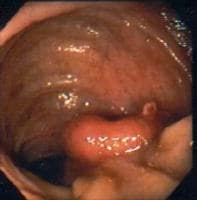Adenomatous polyps are, by definition, neoplastic. Although benign, they are the direct precursors of adenocarcinomas and follow a predictable cancerous temporal course unless interrupted by treatment. They can be either pedunculated or sessile. Polyps are generally asymptomatic but may occasionally ulcerate and bleed; uncommonly, they may result in obstruction if very large. Adenomas are divided into 3 subtypes based on histologic criteria, as follows: (1) tubular, (2) tubulovillous, and (3) villous. According to World Health Organization (WHO) criteria, villous adenomas are composed of greater than 80% villous architecture. Tubular adenomas are encountered most frequently (80-86%). Tubulovillous adenomas are encountered less frequently (8-16%), and villous adenomas are encountered least frequently (5%).
See the images below.
 Endoscopic view of a sessile polyp, which histology studies revealed to be a villous adenoma. Courtesy of H. Chaun, MD.
Endoscopic view of a sessile polyp, which histology studies revealed to be a villous adenoma. Courtesy of H. Chaun, MD.  Endoscopic view of a sessile polyp histologically determined to be a villous adenoma. Courtesy of R. Enns, MD.
Endoscopic view of a sessile polyp histologically determined to be a villous adenoma. Courtesy of R. Enns, MD.  Histology of villous adenoma. Fingerlike projections stretching from the surface of a polyp downward with minimal branching. Courtesy of D. Owen, MD.
Histology of villous adenoma. Fingerlike projections stretching from the surface of a polyp downward with minimal branching. Courtesy of D. Owen, MD.  Histology of villous adenoma. Low-grade dysplasia with loss of mucin, prominent nucleoli, and hyperchromatic and elongated cells. Courtesy of D. Owen, MD.
Histology of villous adenoma. Low-grade dysplasia with loss of mucin, prominent nucleoli, and hyperchromatic and elongated cells. Courtesy of D. Owen, MD.
Villous adenomas are associated more often with larger adenomas and more severe degrees of dysplasia. These adenomas occur more frequently in the rectum and rectosigmoid, although they may occur anywhere in the colon. They generally are sessile structures that appear as velvety or cauliflowerlike projections. Although rare, villous adenomas of the duodenum and the small bowel, particularly at the ampulla, can occur. Villous adenomas are of concern primarily because of the risk of malignant transformation (approximately 15-25% overall but higher once >2 cm).
The primary focus of this article is colonic villous adenomas. Where appropriate, certain aspects of small bowel villous adenomas are addressed
See the images below.
 Endoscopic view of a sessile polyp, which histology studies revealed to be a villous adenoma. Courtesy of H. Chaun, MD.
Endoscopic view of a sessile polyp, which histology studies revealed to be a villous adenoma. Courtesy of H. Chaun, MD.  Endoscopic view of a sessile polyp histologically determined to be a villous adenoma. Courtesy of R. Enns, MD.
Endoscopic view of a sessile polyp histologically determined to be a villous adenoma. Courtesy of R. Enns, MD.  Histology of villous adenoma. Fingerlike projections stretching from the surface of a polyp downward with minimal branching. Courtesy of D. Owen, MD.
Histology of villous adenoma. Fingerlike projections stretching from the surface of a polyp downward with minimal branching. Courtesy of D. Owen, MD.  Histology of villous adenoma. Low-grade dysplasia with loss of mucin, prominent nucleoli, and hyperchromatic and elongated cells. Courtesy of D. Owen, MD.
Histology of villous adenoma. Low-grade dysplasia with loss of mucin, prominent nucleoli, and hyperchromatic and elongated cells. Courtesy of D. Owen, MD. Villous adenomas are associated more often with larger adenomas and more severe degrees of dysplasia. These adenomas occur more frequently in the rectum and rectosigmoid, although they may occur anywhere in the colon. They generally are sessile structures that appear as velvety or cauliflowerlike projections. Although rare, villous adenomas of the duodenum and the small bowel, particularly at the ampulla, can occur. Villous adenomas are of concern primarily because of the risk of malignant transformation (approximately 15-25% overall but higher once >2 cm).
The primary focus of this article is colonic villous adenomas. Where appropriate, certain aspects of small bowel villous adenomas are addressed
ليست هناك تعليقات:
إرسال تعليق